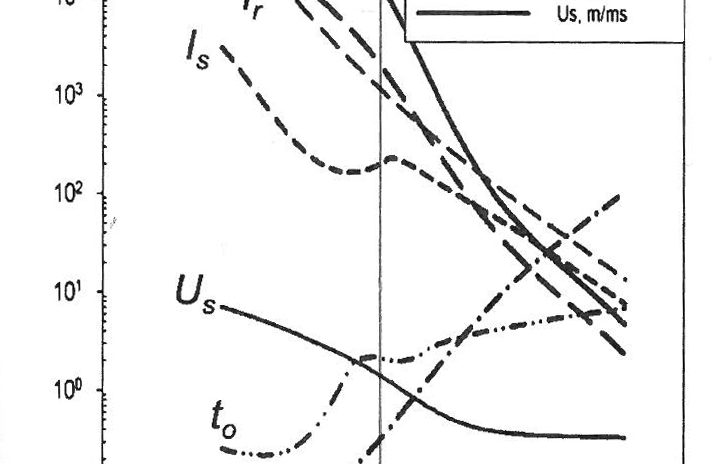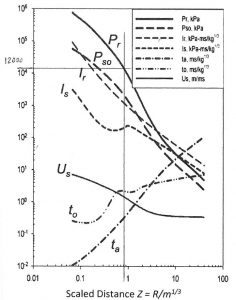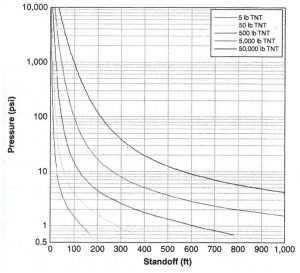L’IMPORTANZA DI UNA PROGETTAZIONE ANTI-ESPLOSIONE NELLE STRUTTURE CIVILI
Blast resistant design for buildings
- 29 Mag 2017

Nonostante le attività di controllo e di Intelligence, la potenzialità di accesso a materiali esplodenti è esponenzialmente cresciuta a livello mondiale negli ultimi 30 anni sia per la dismissione di arsenali militari sia per l’allargamento delle aree di conflittualità geopolitica, nonché anche in termini di incremento di opportunità di movimentazione di merci, di masse umane e di interessi ad attività terroristiche. A tale situazione si aggiunge la possibilità di acquisizione sul mercato normale di numerosi prodotti chimici in commercio per fini del tutto leciti ma utilizzabili, con minime modifiche, come esplosivi (clorato di sodio, nitrobenzene, nitrato di ammonio, dicloroisocianato di sodio,…).
Se poi consideriamo che, soltanto limitandoci al TNT con una densità di 1600 Kg/mc (il C-4 è similmente dell’ordine di 1590 Kg/mc ed il PBX-9404 addirittura superiore e di 1810 Kg/mc), è possibile movimentare 10 Kg di esplosivo in un cubo di 18 cm di lato ovvero 100 kg in uno di 40 cm, possiamo comprenderne la facilità di trasporto.
Analogamente, in termini di azione distruttiva si può osservare che con soli 10 Kg di TNT anche solamente appoggiati ad un pilastro di cemento armato di 80x80cm, l’esplosione ottenibile è già in grado di asportarne una porzione di circa 60 cm di raggio, lasciando una sezione resistente di soli 20 cm e quindi collassabile.


Pertanto emerge chiaramente il grave livello di danno e di pericolosità che pur modeste quantità di esplosivo, facilmente trasportabili e posizionabili, possono arrecare alle strutture di un edificio e quindi alle persone. E questo anche semplicemente limitandosi ad azioni locali, ossia tralasciando gli effetti generati dall’esplosione ad opera dalle onde di pressione riflesse ed incidenti sulle strutture generalizzate (100 Kg di TNT ad una distanza di 4 m generano una pressione impulsiva di 12000 KPa a fronte di una pressione atmosferica standard di circa 101 KPa) e sugli elementi non strutturali sia in termini di messa fuori servizio sia di frammentazione e di penetrazione/perforazione.
Nella situazione attuale di dispersione e di riduzione delle fonti economiche di finanziamento, è quindi evidente come per una cellula terroristica, la semplicità di utilizzo di esplosivi per azioni dirette, su larga scala e di contemporaneità, con un minimo impegno di risorse umane e con effetti fortemente impattanti, rappresenti una soluzione “sempre più economica”.
E’ quindi importante valutare, sicuramente con diversi livelli di attenzione ma comunque sempre, nell’ambito di una corretta progettazione di edifici strategici civili (sedi di organismi governativi, uffici territoriali di Governo, ospedali, centrali energetiche e di comunicazione, stazioni aeroportuali, …, ma anche scuole e finanche strutture alberghiere e ricettive significative), sia in termini di realizzazione ex novo sia di ristrutturazione, l’introduzione di strutture in grado di resistere ad azioni esplosive. L’approccio progettuale si traduce in generale nell’adozione di misure di protezione rappresentate da:
- creazione di perimetrazioni di sicurezza;
- introduzione di superfici in grado di collassare sotto sovrappressioni prestabilite;
- introduzione di giunti strutturali allo scopo di separare/compartimentare porzioni di edificio a rischio di esplosione;
- prevenzione di crolli significativi in conseguenza di cedimenti strutturali localizzati;
- introduzione di scelte specifiche e mirati per gli involucri edilizi (a secco con pannelli a masse con assorbimenti inerziali, pareti finestrate antiframmentazione, …).
Tale attività richiede una struttura esperta e dedicata alla progettazione integrata che consenta di realizzare un’implementazione diretta contemporanea relativamente a:
- ambito architettonico, potendo utilizzare elementi dissuasori standard con funzione di barriere di controllo autoveicoli o con sistemi di arresto degli stessi tramite elementi di ostacolo a rialzo automatico, ovvero integrato in elemento di arredo urbano (es. fioriere). Lo stesso per pannelli ad assorbimento anti-esplosioni o film di contenimento su parti vetrate e paramenti murari.
- calcolo/dimensionamento delle strutture (o nella verifica nel caso di interventi di miglioramento strutturale) quali travi, pilastri, solai, muri di contenimento permettendo di introdurre od utilizzare elementi di normale uso ad esempio per protezione all’azione sismica (es. isolatori) con funzione anti shock rispetto all’azione esplosiva ovvero dimensionare le armature in modo da creare cerniere plastiche (plastic hinge) negli elementi strutturali al fine di consentire la deformazione della la struttura ma non il suo collasso ed impedire rotture fragili per taglio (shear)
- ambito impiantistico per una corretta taratura dei sistemi standard di building automation nei complessi HVAC al fine di poter sfruttare sistemi già previsti ma con funzioni di blocco o di isolamento settorializzato dei sistemi di condizionamento. E così, in modo analogo, per quando riguarda i sistemi di controllo sui ascensori ed impianti di sollevamento creando scenari di salvaguardia con accessi interdetti e di conservazione delle caratteristiche a prova di fumo in base alla zona di attacco. Medesime considerazioni vanno fatte per le componenti elettriche e di illuminazione.
Tutti elementi che se correttamente valutati e progettati in modo esperto consentono di realizzare effettivi livelli di sicurezza introducendo incrementi di costo praticamente non significativi rispetto all’impegno economico di base (circa il 20-30% in più) ed ovviamente all’importanza dell’opera nonché agli effetti che un’azione terroristica sulla stessa produrrebbe.
Ing. Paolo Croce – ZED PROGETTI srl
Despite the control and intelligence activities, the possibilities for crime, terrorist and insurgent groups to get and utilize explosive materials have worldwide exponentially risen over the last 30 years, both for the dismantling or dissolution of military arsenals as well as a result of the expansion of the areas of geopolitical conflicts. These factors are increasingly combining with concomitant changes in terms of movement of goods and human masses for business, commercial, or tourist-related activities. Such masses can easily pose as the target of subjects which find few difficulties in purchasing on legitimate markets normal chemicals which, with minimal modifications, may be transformed in powerful explosives (sodium chloride, nitrobenzene, ammonium nitrate, sodium dichloroisocyanate, etc.).
For a better understanding of the terms of the risks we are hereby considering, the notorious explosive known as TNT, with a density of 1600 Kg / mc (the same value is 1590 Kg / mc for the C-4 and 1810 Kg / mc for the PBX-9404), makes possible to move or transport, in practical terms, 10 Kg explosive in a 18 cm cubic case, or 100 kg in a 40 cm one.
By focusing instead on the destructive potential, it is worthwhile to point out how only 10 Kg of TNT leaning on an 80x80cm reinforced concrete pillar are sufficient to remove a portion of about 60 cm radius, leaving a resistant section of only 20 cm therefore susceptible to a total collapse.
Therefore, there is a serious level of damage and risks determined by modest quantities of easily transportable explosive, which can be positioned and triggered for destroying infrastructures and then harming the persons hosted inside. The matter can assume even a more alarming dimension if the action of shock waves is being considered, both for what is concerning the structural elements (100 Kg of TNT at a 4 m distance generate an impulse pressure of 12,000 KPa in comparison to a standard atmospheric pressure of about 101 KPa) as well as the non-structural elements in terms of fragmentation, penetration and puncturing effects.
It is evident as hostile and even loosely organized cells can arrange direct, large-scale and simultaneous actions, with a minimum commitment of human resources and maximization of effects, maybe with the concomitant usage of commercial drones and home-made loitering ammunitions for delivering ready-to-use explosive materials in the weak spots of targeted infrastructures.It’s important to offer well-tested integrated and modular approaches in projecting and designing ex-novo infrastructures or restructuring the old ones, with a focus combining “desired level of resilience vs. cost-benefits margins”, in order to make BOMB PROOF buildings like government agencies’ and companies’ HQ, hospitals, law enforcements’ and military barracks, energy and communication installations, airports, schools, and hotels and resort facilities). This capability will focus essentially of the adoption of SCIENTIFICALLY PROVEN protective measures represented by:
- Creation of security perimeters according to well-tested blast radius parameters;
- Adoption, for non-vital components of infrastructures, of surfaces able to controlled and pre-planned collapse under the overpressures’ stress;
- Adoption of structural joints supposed to separate/compartment non-vital areas of the building at the moment of explosion;
- Solutions aimed to prevent/mitigate significant collapses which can derive from localized structural failure;
- Adoption of specific solutions for building weak spots (like dry massive panels with inertial absorption, anti-fracturing walls, etc.)
Such focuses require an expert and dedicated activity of designing, which, due to an integrated approach, will allow the implementation:
- by architectural design – using standard bollards (or similar to) as control barriers or car-stopping systems by automatic pickin up obstacles eventually integrated in street furniture (e.g. flower boxes). The same goes by adotpting anti-blast panels or restraint films on glazed elements and walls.
- by structural shaping – of beams, columns, slabs, cantilever walls or the use of standard elements for protection against seismic action (e.g. seismic isolators ) with an anti shock function against explosive action or dimensioning the reinforcing steel to create plastic hinges so to allow deformation of the structure but not its collapse and to prevent a fragile-shear break.
- by a correct regulation of the standard building automation systems for HVAC plants – in order to use the same normal items for anti – blast purpose by means of localized interruptions in the air-conditioning. And, similarly setting up the lift control systems so to create safeguard scenarios by interrupted accesses and smoke-tight characteristics in the blast area. The same considerations can be made for electrical and lighting components.
All these topics, if correctly analyzed and expertly designed, can provide real levels of safety by introducing an insignificant cost increase (about 20-30% more than a no anti – blast designed building) if compared to life, the importance of the building and as well as the effects that a terrorist action can produce.

